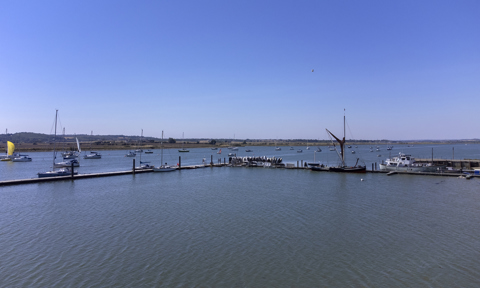The following article first appeared in the February 2023 edition of Yachting Monthly. The column is written by Dick Durham. Thanks to the Yachting Monthly team for sharing this wonderful column with us.
Visit www.yachtingmonthly.com or subscribe for a digital/print copy.
The man in the creek
This year an old shed on the Essex marshes will be decked in bunting celebrating its centenary as the HQ of the North Fambridge Yacht Club, the meeting place of many old hands from Yachting Monthly. They include Maurice Griffiths, editor for more than 40 years; Mike Peyton, the world-famous yachting cartoonist; and, almost forgotten in the mists of time, prolific contributor F. B. Cooke.
Francis Bernard Cooke, or FBC as he signed himself, was the original ‘man-in-the-creek’: an observer of small boat sailing, building, and owning in pre-Great War Britain. He actually founded the club in 1898 as the Fambridge Yacht Club in the days when a ferryman rowed people across the River Crouch from one half of the disembodied village to the other. But following the First World War and the loss in that conflict of many members, the club perished too, and by the time it was re-formed in 1973, the ferryman was long gone and so NFYC it became.
Cooke, a merchant banker, was the doyen of how-to books and articles on sailing, so much so that he was offered the editorship of YM, but turned it down describing such a berth as ‘a much too precarious career.’
Last year, FBC’s granddaughter, Faith Egan, discovered his unpublished autobiography My Early Years At Sea, which I have now read. In his favourite boat, Snipe, a 2.5-tonne canoe-stern sloop built at Teignmouth in 1895 by Pengelly and Gore, he explored all the creeks and rivers between Lowestoft and the Thames.
And aboard this boat FBC had, for once, more to say about the performance of the crew than the craft during a cruise from Fambridge to Lowestoft. He wrote an hilarious account of that cruise reminiscent of Three Men in A Boat. This is the first time any excerpts have been published.
FBC describes his crew dismissively as ‘the Passenger’ who refused to stand a watch, take an oar in a calm, prepare food: ‘I can’t work the stove’ or even do the washing up: ‘leave it in a bucket till we get in.’
I heard howls of rage as his beautiful white trousers were plastered in mud
At Lowestoft – with a band playing on the pier – the Passenger prepared to go ashore: ‘Lugging his portmanteau from the foc’sle he opened it on the cabin top and commenced his toilet. First, he shaved then put on a moustache trainer. Then he produced a blue jacket with brass buttons and hung it over the boom in the sun to take out the creases. Coming into the cabin he put on a pair of white flannel trousers and a pink shirt.
Returning to the cockpit he pipe-clayed his shoes and stood them on the cabin-top to dry. Then, removing the moustache trainer, rubbed his cheeks with face cream.’ Having dressed his hair the Passenger then donned a yachting cap with shiny peak and white cover adorned with a club burgee ‘which looked uncommonly like that of the Royal Yacht Squadron’, but it was home-made!
While the Passenger was ashore FBC had decided to move from Lowestoft Basin and into Oulton Broad, much to his crew’s consternation, as he was due to meet a girl in town. Later, FBC raised the anchor to move back into Lowestoft Basin: ‘…the bottom of Oulton Broad is composed of black mud of the consistency of condensed milk and the chain came up thickly coated with it… a moment later I heard howls of rage and indignation… the dirty cable had run down into his bag, plastering is beautiful white trousers and fancy shirt with black mud.’
FBC made many contacts including top dinghy sailor Uffa Fox, J Class owner Sir Thomas Lipton and sail-furler inventor Major Wykeham-Martin. He also founded the East Coast Mutual Yacht Insurance Association, which only folded last year, and was elected an honorary member of the Cruising Association. His career as a yachting journalist saw him cover Britannia sailing her first race in the Thames Estuary in 1893; Kaiser Wilhelm II board Meteor off Cowes in 1906, and the challenge for the America’s Cup by Sopwith’s Endeavour, in 1934. Not bad for ‘the man in the creek.’

